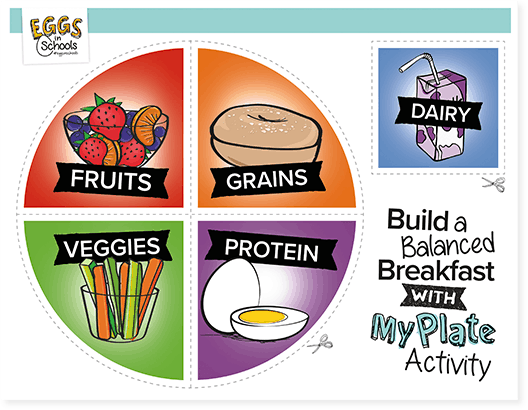Build a Balanced Breakfast with MyPlate Activity

Learning Objectives
Students will be able to:
- Describe the five food groups on MyPlate.
- Build a balanced breakfast with at least three out of the five food groups from MyPlate.
- Describe different examples of a balanced breakfast.
- Explain the benefits of eating a healthy balanced breakfast.
MyPlate
This lesson centers on the MyPlate Plan – from the USDA Center for Nutrition Policy and Promotion, which encourages people to find a healthy eating style by eating meals made from the five food groups—fruits, vegetables, dairy, proteins and grains.
MyPlate depicts a place setting with a plate and glass divided into five food groups.
Benefits of Breakfast
Numerous research studies show that students who eat breakfast—either at school or home—have better academic performance and behavior.1 When children eat better, they learn better. A well-balanced breakfast, rich in protein, whole grains, fruits/vegetables and low-fat/fat-free milk gives children the energy they need to learn and stay active. Breakfast options that include eggs present opportunities to include other nutrient-dense foods encouraged by the 2015 Dietary Guidelines for Americans, such as vegetables and whole grains. Egg consumption by American children and adolescents is associated with intake of several nutrients, including higher protein, polyunsaturated, monounsaturated and total fat, α-linolenic acid, docosahexaenoic acid, choline, lutein + zeaxanthin, vitamin D, potassium, phosphorus, and selenium.2
Classroom MyPlate Activity
Materials Needed:
1 Large basket, bucket or another vessel
Cards depicting five food groups
OPTIONAL: Print out MyPlate Pick3 breakfast and lunch posters as visual aids on our Tools for Schools page

Lesson Preparation:
Print an equal number of place settings of cards (5), so there is one food group card for each student. Optimally, total number of students is divisible by five. If not, some students may have to represent more than one food group. Cut each sheet into five cards.
Each MyPlate card set includes the following groups/colors:
Vegetables/green
Fruits/red
Dairy/blue
Proteins/purple
Grains/orange
Place food group cards in basket/bucket, ensuring there are enough for each student to get at least one. Mix them together.
Grade level: 2nd and 3rd
Estimated time: 15 minutes
Instructions
1) Ask students if they can name the five food groups. Once all the food groups are identified, ask the students to name some foods that fit into each group.
- Fruits
Any fruit or 100% fruit juice counts as part of the Fruit Group. Fruits may be fresh, canned, frozen, or dried, and may be whole, cut-up, or pureed. - Vegetables
Any vegetable or 100% vegetable juice counts as a member of the Vegetable Group. Vegetables may be raw or cooked; fresh, frozen, canned, or dried/dehydrated; and may be whole, cut-up, or mashed. - Dairy
All fluid milk products and many foods made from milk are considered part of this food group. Foods made from milk that retain their calcium content are part of the group. Foods made from milk that have little to no calcium, such as cream cheese, cream, and butter, are not. Calcium-fortified soymilk (soy beverage) is also part of the Dairy Group. - Proteins
All foods made from eggs, meat, poultry, seafood, beans and peas, processed soy products, nuts and seeds are considered part of the Protein Group. - Grains
Any food made from wheat, rice, oats, cornmeal, barley or another cereal grain is a grain product. Bread, pasta, oatmeal, breakfast cereals, tortillas, and grits are examples of grain products. Grains are divided into 2 subgroups, Whole Grains and Refined Grains
2) Introduce MyPlate briefly, and the importance of a balanced meal, including the different food groups—especially protein, like eggs. (MyPlate posters can be a good visual aid.)
3) Next, have students pull one food group card from the basket. Once everyone has a card, have the students form groups of five—each student in a group must have a different color/food group card. (If the number of students is not divisible by five, either have the extra students double up in one of the other groups or give the smaller group the extra cards needed to cover all five food groups.)
4) When students are in groups, have them share which food group they have—whether it’s protein, grain, fruit, veggies or dairy. Then ask them to create a well-balanced breakfast plate with at least three out of the five food group cards. Students can suggest foods for a meal from the food group(s) they represent.
5) Finish with final thoughts on MyPlate.
- Emphasize how eating a balanced breakfast can help them grow and learn better.
- Eating breakfast gives them energy.
- High-quality protein options, like eggs, are important to help them stay full, so they can focus on their schoolwork.
- Did you know? Eggs have protein and important nutrients that help you stay focused in school!
- Eggs can be eaten any time for breakfast, lunch, dinner or snacks.
Suggested Companion Resources
Educational Handouts For Parents
Eat Better. Learn Better. with School Breakfast
Eggucational Fun & Games For The Classroom
Egg Nutrition Memory Card Game
References
- Food Research & Action Center, Research Brief: Breakfast for Learning. This brief was originally prepared in September 2011 and updated in the spring of 2014 by FRAC’s Madeleine Levin, MPH, Senior Policy Analyst. This brief was updated again in October 2016 by FRAC’s Heather Hartline-Grafton, DrPH, RD, Senior Nutrition Policy and Research Analyst.
- Papanikolaou, Y. and V.L. Fulgoni, 3rd, Egg Consumption in U.S. Children is Associated with Greater Daily Nutrient Intakes, including Protein, Lutein + Zeaxanthin, Choline, alpha-Linolenic Acid, and Docosahexaenoic Acid. Nutrients, 2019. 11(5).
